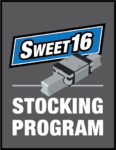Are you interested in a longer bearing life? How does 10-year bearing lifetime sound versus 6-months? In this three-part webinar series, Morrell Group's Ty Huser and Shawn Stearn will help you understand ball bearings and how to avoid common pitfalls leading to shorter bearing life. Watch the replay or read below for more information.
What You Will Learn in Part One
- Common Bearing and Ball Screw Applications
- Failure Theories for Bearings
- Benefits of Varied Loading
- Helpful Sizing and Configuration Tools
Watch the Webinar Recording
Meet the Speakers
Ty Huser
Ty Huser has a Bachelor of Science in Industrial Engineering from Purdue University and an MBA from the University of Indianapolis. He has 23 years of Sales Engineering experience in fluid power, mechanical and controls systems including time spent as a Mechanical Product Manager at Morrell Group.
Shawn Stearn
Shawn Stearn has a Bachelor of Science in Mechanical Engineering from the Wolverine Victors at the University of Michigan. He has extensive experience with mounted bearings, linear bearings many types of mechanical drive systems - specializing in high precision, high speeds & high forces. He has over 25 years’ experience installing power transmission and motion control applications mechanically and electrically: 15 of which have been at Morrell Group.
About Morrell Group
With full-service design and engineering services, a line card comprised of the machine and motion control industry’s most trust brands – Lead off by Bosch Rexroth, SICK Intelligence & Emerson/AVENTICS– and a comprehensive customer support network: Morrell Group is much more than a distributor. We are:
An Engineering Partner
A Systems Integrator
A Value-Added Distributor
What is a bearing?
Bearings allow for motion while holding a load position. Bearings allow for parts to roll around each other instead of against each other. Bearings also reduce the friction between moving metal parts. They also reduce stress and allow for great efficiency while increasing machine life. There are many types of Rolling Element Bearings that use balls or rollers, needle rollers fall into the latter category.
There are three main types of linear bearings. One is profiled rail systems, which use both balls and rollers. A less precise, more economical linear bearing uses balls on precision shafting. You may recognize this made by Thomson. Linear bearings may also cam followers. Morrell Group offers all three of these.
Bearings are in so many different things such as wheels, spindles and engines. Most of the products Morrell sells also have rotary bearings.
Linear Bearing and Ball Screw Applications
Morrell Group’s biggest bearing product line is the Rexroth linear guided bearings. We sell millions of dollars of profiled rail and runner blocks every year and stock a million dollars of inventory so we can achieve the fastest market delivery of cut-to-length rail. Look for Morrell's Sweet 16 stocking program at www.morrell-group.com/sweet16.
Bearing application theories apply across all rolling element bearings - rotary, linear and screw. You will find linear bearings in processes that are milling, cutting, grinding, polishing, routing, water jetting, welding, machine loading, assembling, heat staking, molding, positioning, testing and many more.
And in many cases, where you find a linear guide system you might find a ball screw that is actuating the slide axis. Ball screws are very similar to a thrust bearing with helix that allows for a high thrust capacity and the circuit provides forward motion. The same bearing life theories apply to ball and roller screws.
Why don’t bearings last for the desired lifetimes during operations?
We have placed important consideration factors into three categories: Design Factors, Environmental Factors, Installation Factors
Why do bearings fail? The top reason is bearing contamination due to poor sealing, maintenance, and environmental issues. The second reason is disassembly. This occurs catastrophically after any of the other reasons listed trashes the bearing system. The third reason bearings fail is from incorrect machine tolerancing or improper installation. Additional reasons bearings fail are insufficient lubrication, corrosion, overload or system crash failure, vibration, exceeding speed ratings, electrical arcing, cage damage, or several more rare issues.
Design Factors
Now let's start with some design issues that are important to understand. The first is the static load capacity. Too often people use this to design in their bearing, but if you are cycling your bearing at loads within even 20% of the static capacity the result will be a very fast metal fatigue failure. To keep this simple, the static capacity is the load limit that will create permanent indentations into the raceways. This will also fail your bearing very quickly.
The basic dynamic capacity is the rating that should be used. Why? Because bearings are dynamic – they are moving, not static. This is used in the bearing life equation that estimates how many cycles the bearings can cycle before failing due to metal fatigue. Typically, the load a bearing supports will be less than 15% of the rated basic dynamic capacity.
The reason bearings fail from metal fatigue is from varied loading on the rolling elements. Bearings circulate the rollers through varied loading - so this is unavoidable. The trick to choose the right bearing that will have an acceptable bearing life.
In Rotary bearings, the rollers are constantly cycling in and out of a load zone. The roller compresses and expands throughout the cycle. Upon approaching fatigue failure a crack will form, then grow, and after that the part with a fracture.
The bearing life equation requires an equivalent load to calculate the bearing life. This takes the combination of radial load, axial load, and moment load and turns it into an equivalent radial load that can be used in the equation. All three of these must be considered in the design. Single bearing systems are the most a risk of having moment rating issues.
For linear systems, the equivalent load takes the pitch, yaw, and roll moments and turns them into an equivalent pressure force that is used in the bearing life equation. Single rail systems are the most a risk of having moment rating issues.
Speed is also a consideration. Ball bearings typically will have higher speed ratings than roller bearings which will skew. Measured in rpm for rotary bearings - a cage will increase the speed capacity. Angular contact ball bearings have higher speed ratings. Speed in linear bearings is measured in feet per minute or meters per second. Just like rotary bearings, balls will have higher speed ratings than rollers. One thing to know is that a cage does not increase speed or load ratings in linear bearings. A cage just lowers the noise. THK uses a cage to retain the balls. Bosch Rexroth retains the balls and rollers without a cage allowing for a full complement and hence a higher dynamic rating. To increase speed capacity Bosch Rexroth offers a ceramic ball the will double the speed to 10 m/s.
Most rotary bearings are such a commodity, that unless you are working with instrumentation, the standard off the shelf bearings will have a high level of precision. General automation profiled linear bearings will typically start at 40 microns of precision and get down to 2-3 microns if you want to pay for it. You want to make sure you consider the combined precision between the runner block and rail. Balls deflect more than rollers, so roller bearings are considered more rigid and more precise. It is also important to note that specifying a preload will increase rigidity and precision, but will reduce bearing life and add drag.
Bosch Rexroth makes all their profiled linear bearings with a patented system called "HP". This system softly pushes the rollers into the load zone where they significantly reduce vibration chatter. Other systems abruptly move the rollers from unloaded to loaded when it passes the corner. This is even worse when the rollers exit the load zone and pop back into a free state - causing even more vibration. Some manufactures claim their cage can do this, but it is very questionable.
Environmental Factors
Many designers overlook lubrication until they go to install the machine, which, in many cases, is too late. Many rotary bearings are lubed for life and I am proud to announce that Rexroth has doubled the profiled linear ball bearing lubrication interval from 10 million meters to 20 million meters. Their profile roller bearings require more frequent lubrication. Morrell Group sells Graco automatic lubrication systems and we are happy to help specify the right system.
Many bearings do not come with seals and the user needs to design their own sealing system. Rotary bearings integrated into most Morrell Group products have seals or shields. The Morrell Group Sweet 16 profiled linear bearings have end seals and longitudinal seals. Chemical compatibility should be checked when using harsh chemicals. Labyrinth or felt seals can be specified if low drag is needed.
Material choice can also be import and in a wet or corrosive environment. Ideally, a thin dense chrome coating can be used to protect steel without lowering ratings. If necessary, 400 series stainless can be specified. It is also important to watch temperature ratings for extremely high or low temperatures. Also, checking grease compatibility or plastic compatibility can get you out of a bind.
Installation Factors
Misalignment and vertical offsets will fail bearings. Spherical roller bearings and self-aligning mounted bearings can compensate for some misalignment, but be sure to follow all vendor recommendations. Tighter Tolerances required on profiled linear bearings will mean paying closer attention to vendor recommendations of misalignment and vertical offsets rail to rail and runner block to runner block. The rails and the runner blocks each have ground reference edges. Linear ball bushings can be purchased with some self-aligning capacity. Note: When the stroke is shorter than 2.5 times the length of the runner block, you have a short stroke situation. Additional lubricating may be required.
Request more info today!
Please fill out the form, give us a call or send us an e-mail. We can't wait to hear from you!
248-373-1600
Sweet 16 Stocking Program
Do you need profiled ball rail or runner blocks fast? You can count on Morrell Group's Sweet 16 Stocking Program to keep you moving. With 16 runner blocks guaranteed in stock and 4m long rails cut-to-length, we can meet all of your linear motion needs in a hurry. Learn more about our Sweet 16 program here.




